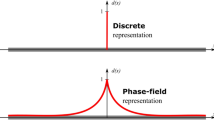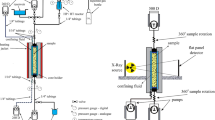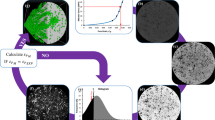Abstract
Mineral precipitation can drastically alter a reservoir’s ability to transmit mass and energy during various engineering/natural subsurface processes, such as geothermal energy extraction and geological carbon dioxide sequestration. However, it is still challenging to explain the relationships among permeability, porosity, and precipitation patterns in reservoirs, particularly in fracture-dominated reservoirs. Here, we investigate the pore-scale behavior of single-species mineral precipitation reactions in a fractured porous medium, using a phase field lattice-Boltzmann method. Parallel to the main flow direction, the medium is divided into two halves, one with a low-permeability matrix and one with a high-permeability matrix. Each matrix contains one flow-through and one dead-end fracture. A wide range of species diffusivity and reaction rates is explored to cover regimes from advection- to diffusion-dominated, and from transport- to reaction-limited. By employing the ratio of the Damköhler (Da) and the Peclet (Pe) number, four distinct precipitation patterns can be identified, namely (1) no precipitation (Da/Pe < 1), (2) near-inlet clogging (Da/Pe > 100), (3) fracture isolation (1 < Da/Pe < 100 and Pe > 1), and (4) diffusive precipitation (1 < Da/Pe < 100 and Pe < 0.1). Using moment analyses, we discuss in detail the development of the species (i.e., reactant) concentration and mineral precipitation fields for various species transport regimes. Finally, we establish a general relationship among mineral precipitation pattern, porosity, and permeability. Our study provides insights into the feedback loop of fluid flow, species transport, mineral precipitation, pore space geometry changes, and permeability in fractured porous media.
Similar content being viewed by others

References
Ahkami, M., Roesgen, T., Saar, M.O., Kong, X.Z.: High-resolution temporo-ensemble PIV to resolve pore-scale flow in 3D-printed fractured porous media. Transport in Porous Media. ISSN 15731634. http://link.springer.com/10.1007/s11242-018-1174-3 (2018)
Souto, H.P.A., Moyne, C.: Dispersion in two-dimensional periodic porous media. Part ii. Dispersion tensor. Phys. Fluids 9(8), 2253–2263 (1997)
Battiato, I., Tartakovsky, D.M.: Applicability regimes for macroscopic models of reactive transport in porous media. J. Contam. Hydrol. 120, 18–26 (2011)
Battiato, I., Tartakovsky, D.M., Tartakovsky, A.M., Scheibe, T.D.: Hybrid models of reactive transport in porous and fractured media. Adv. Water Resour. 34(9), 1140–1150 (2011)
Beckingham, L.E.: Evaluation of macroscopic porosity-permeability relationships in heterogeneous mineral dissolution and precipitation scenarios. Water Resour. Res. 53(12), 10217–10230 (2017)
Brenner, H.: Dispersion resulting from flow through spatially periodic porous media. Philos. Trans. R. Soc. London. Series A Math. Phys. Sci. 297(1430), 81–133 (1980)
Carman, P.C.: Fluid flow through granular beds. Trans. Inst. Chem. Eng. 15, 150–166 (1937)
Chen, L., Zhang, R., Min, T., Kang, Q., Tao, W.: Pore-scale study of effects of macroscopic pores and their distributions on reactive transport in hierarchical porous media. Chem. Eng. J. 349, 428–437 (2018). ISSN 13858947
Daccord, G., Lietard, O., Lenormand, R.: Chemical dissolution of a porous medium by a reactive fluid—ii. Convection vs reaction, behavior diagram. Chem. Eng. Sci. 48(1), 179–186 (1993)
Davis, M.A., Walsh, S.D.C., Saar, M.O.: Statistically reconstructing continuous isotropic and anisotropic two-phase media while preserving macroscopic material properties. Phys. Rev. E 83(2), 026706 (2011)
Flekkøy, E.G., Oxaal, U., Feder, J., Jøssang, T.: Hydrodynamic dispersion at stagnation points: simulations and experiments. Phys. Rev. E. 52(5), 4952 (1995)
Flukiger, F., Bernard, D.: A new numerical model for pore scale dissolution of calcite due to co2 saturated water flow in 3d realistic geometry: principles and first results. Chem. Geol. 265(1–2), 171–180 (2009)
Ghezzehei, T.A.: Linking sub-pore scale heterogeneity of biological and geochemical deposits with changes in permeability. Adv. Water Resour. 39, 1–6 (2012)
Grosfils, P., Boon, J.P.: Viscous fingering in miscible, immiscible and reactive fluids. Int. J. Modern Phys. B 17(01n02), 15–20 (2003)
Grosfils, P., Boon, J.P., Chin, J., Boek, E.S.: Structural and dynamical characterization of hele–shaw viscous fingering. Philos. Trans. R. Soc. London. Series A: Math. Phys. Eng. Sci. 362(1821), 1723–1734 (2004)
Guo, Z., Zheng, C., Shi, B.: Discrete lattice effects on the forcing term in the lattice Boltzmann method. Phys. Rev. E 65(4), 046308 (2002)
Hoefner, M.L., Fogler, H.S.: Pore evolution and channel formation during flow and reaction in porous media. AIChE J 34(1), 45–54 (1988)
Horn, F.J.M.: Calculation of dispersion coefficients by means of moments. AIChE J 17(3), 613–620 (1971)
Huber, C., Shafei, B., Parmigiani, A.: A new pore-scale model for linear and non-linear heterogeneous dissolution and precipitation. Geochim. Cosmochim. Acta 124, 109–130 (2014)
Kang, Q., Zhang, D., Chen, S., He, X.: Lattice Boltzmann simulation of chemical dissolution in porous media. Phys. Rev. E 65(3), 036318 (2002)
Kang, Q., Lichtner, P.C., Zhang, D.: Lattice Boltzmann pore-scale model for multicomponent reactive transport in porous media. J. Geophys. Res.: Solid Earth 111(5), 1–12 (2006). ISSN 21699356
Kang, Q., Lichtner, P.C., Janecky, D.R.: Lattice boltzmann method for reacting flows in porous media. Adv. Appl. Math. Mech 2(5), 545–563 (2010)
Kang, Q., Chen, L., Valocchi, A.J., Viswanathan, H.S.: Pore-scale study of dissolution-induced changes in permeability and porosity of porous media. J. Hydrol. 517, 1049–1055 (2014)
Katz, G.E., Berkowitz, B., Guadagnini, A., Saaltink, M.W.: Experimental and modeling investigation of multicomponent reactive transport in porous media. J. Contam. Hydrol. 120, 27–44 (2011)
Kim, D., Peters, C.A., Lindquist, W.B.: Upscaling geochemical reaction rates accompanying acidic co2-saturated brine flow in sandstone aquifers. Water Resour. Res. 47, 1 (2011)
Kong, X.-Z., Saar, M.O.: Numerical study of the effects of permeability heterogeneity on density-driven convective mixing during co2 dissolution storage. Int. J. Greenhouse Gas Control 19, 160–173 (2013)
Laleian, A., Valocchi, A., Werth, C.: An incompressible, depth-averaged lattice Boltzmann method for liquid flow in microfluidic devices with variable aperture. Computation 3(4), 600–615 (2015)
Lapidus, L., Amundson, N.R.: Mathematics of adsorption in beds. vi. The effect of longitudinal diffusion in ion exchange and chromatographic columns. J. Phys. Chem. 56(8), 984–988 (1952)
Leverett, M.C.: Capillary behavoir in porous solids. Trans. AIME 142, 159–172 (1941)
Li, L., Peters, C.A., Celia, M.A.: Upscaling geochemical reaction rates using pore-scale network modeling. Adv. Water Resour. 29(9), 1351–1370 (2006)
Liu, H.-H., Zhang, G., Yi, Z., Wang, Y.: A permeability-change relationship in the dryout zone for co2 injection into saline aquifers. Int. J. Greenhouse Gas Control 15, 42–47 (2013)
Luhmann, A.J., Kong, X.-Z., Tutolo, B.M., Garapati, N., Bagley, B.C., Saar, M.O., Seyfried, JrW E: Experimental dissolution of dolomite by co2-charged brine at 100 c and 150 bar: evolution of porosity, permeability, and reactive surface area. Chem. Geol. 380, 145–160 (2014)
Luquot, L., Rodriguez, O., Gouze, P.: Experimental characterization of porosity structure and transport property changes in limestone undergoing different dissolution regimes. Transp. Porous Media 101(3), 507–532 (2014)
Mehmani, Y., Sun, T., Balhoff, M.T., Eichhubl, P., Bryant, S.: Multiblock pore-scale modeling and upscaling of reactive transport: application to carbon sequestration. Transp. Porous Media 95(2), 305–326 (2012)
Molins, S., Trebotich, D., Steefel, C.I., Shen, C.: An investigation of the effect of pore scale flow on average geochemical reaction rates using direct numerical simulation. Water Resour. Res. 48, 3 (2012)
Niu, Q., Zhang, C.: Permeability prediction in rocks experiencing mineral precipitation and dissolution: a numerical study. Water Resources Research (2019)
Nogues, J.P., Fitts, J.P., Celia, M.A., Peters, C.A.: Permeability evolution due to dissolution and precipitation of carbonates using reactive transport modeling in pore networks. Water Resour. Res. 49(9), 6006–6021 (2013)
Noiriel, C., Steefel, C.I., Yang, L., Bernard, D.: Effects of pore-scale precipitation on permeability and flow. Adv. Water Resour. 95, 125–137 (2016). ISSN 03091708
Parmigiani, A., Huber, C., Bachmann, O., Chopard, B.: Pore-scale mass and reactant transport in multiphase porous media flows. J. Fluid Mech. 686, 40–76 (2011)
Parmigiani, A, Di Palma, P.R., Leclaire, S., Habib, F., Kong, X.-Z.: Characterization of transport-enhanced phase separation in porous media using a lattice-Boltzmann method. Geofluids, https://doi.org/10.1155/2019/5176410 (2019)
Qian, Y., D’Humieres, D., Lallemand, P.: {L}attice {BGK} models for the {N}avier-{S}tokes equation. Europhys. Lett. 17, 479–484 (1992)
Saar, M.O., Manga, M.: In vesicular basalts. Geophys. Res. Lett. 26(1), 111–114 (1999)
Shih, H.C., Huang, C.L.: Image analysis and interpretation for semantics categorization in baseball video. Proceedings ITCC 2003, International Conference on Information Technology: Computers and Communications 94(3), 379–383 (2003). ISSN 0031-899X. https://doi.org/10.1109/ITCC.2003.1197559
Singh, M., Mohanty, K.K.: Permeability of spatially correlated porous media. Chem. Eng. Sci. 55(22), 5393–5403 (2000)
Steefel, C.I., Lasaga, A.C.: Evolution of dissolution patterns: permeability change due to coupled flow and reaction. Chem. Model. Aqueous Syst. II(416), 212–225 (1990)
Steefel, C.I., Lasaga, A.C.: A coupled model for transport of multiple chemical species and kinetic precipitation/dissolution reactions with application to reactive flow in single phase hydrothermal systems. Am. J. Sci. 294(5), 529–592 (1994)
Steefel, C.I., DePaolo, D.J., Lichtner, P.C.: Reactive transport modeling: an essential tool and a new research approach for the earth sciences. Earth Planet. Sci. Lett. 240(3–4), 539–558 (2005)
Stewart, M.L., Ward, A.L., Rector, D.R.: A study of pore geometry effects on anisotropy in hydraulic permeability using the lattice-Boltzmann method. Adv. Water Resour. 29(9), 1328–1340 (2006)
Succi, S.: The lattice Boltzmann equation: for fluid dynamics and beyond. Oxford University Press (2001)
Szymczak, P., Ladd, A.J.C.: Wormhole formation in dissolving fractures. J. Geophys. Res.: Solid Earth 114, B6 (2009)
Tartakovsky, A.M., Meakin, P., Scheibe, T.D., Wood, B.D.: A smoothed particle hydrodynamics model for reactive transport and mineral precipitation in porous and fractured porous media. Water Resour. Res., 43(5). ISSN 00431397. (2007)
Tartakovsky, A.M., Redden, G., Lichtner, P.C., Scheibe, T.D., Meakin, P.: Mixing-induced precipitation: experimental study and multiscale numerical analysis. Water Resour. Res. 44, 6 (2008)
Tartakovsky, A.M., Scheibe, T.D., Meakin, P.: Pore-scale model for reactive transport and biomass growth. J. Porous Media 12, 5 (2009)
Varloteaux, C., Vu, M.T., Békri, S., Adler, P.M.: Reactive transport in porous media: pore-network model approach compared to pore-scale model. Phys. Rev. E 87(2), 023010 (2013)
Venturoli, M., Boek, E.S.: Two-dimensional lattice-Boltzmann simulations of single phase flow in a pseudo two-dimensional micromodel. Physica A: Stat. Mech. Appl. 362(1), 23–29 (2006).
Walsh, S.D.C., Saar, M.O.: Interpolated lattice boltzmann boundary conditions for surface reaction kinetics. Phys. Rev. E 82(6), 066703 (2010)
Walsh, S.D.C., Saar, M.O.: Macroscale lattice-Boltzmann methods for low peclet number solute and heat transport in heterogeneous porous media. Water Resour. Res., 46(7) (2010)
Walsh, S.D.C., Burwinkle, H., Saar, M.O.: A new partial-bounceback lattice-Boltzmann method for fluid flow through heterogeneous media. Comput. Geosci. 35(6), 1186–1193 (2009)
Yoon, H., Valocchi, A.J., Werth, C.J., Dewers, T.: Pore-scale simulation of mixing-induced calcium carbonate precipitation and dissolution in a microfluidic pore network. Water Resour. Res., 48(2). ISSN 00431397. https://doi.org/10.1029/2011WR011192 (2012)
Zimmerman, R.W., Bodvarsson, G.S.: Hydraulic conductivity of rock fractures. Transp. Porous Media 23(1), 1–30 (1996)
Acknowledgements
This work was supported by ETH Grant ETH-12 15-2. The Werner Siemens Foundation (Werner Siemens-Stiftung) is further thanked by Martin Saar for its support of the Geothermal Energy and Geofluids (GEG.ethz.ch) Group at ETH Zurich. We thank the two anonymous reviewers for their helpful comments and suggestions that improved this paper.
Author information
Authors and Affiliations
Corresponding author
Ethics declarations
Conflict of interests
The authors declare that they have no conflict of interest.
Additional information
Publisher’s note
Springer Nature remains neutral with regard to jurisdictional claims in published maps and institutional affiliations.
Appendices
Appendix A: fluid dynamics solver
In a D2Q9 lattice-Boltzmann method (LBM), the particle velocity vector, vi, in Eq. 1 is defined as
where i = 0 indicates the rest velocity, i = 1 − 4 indicates velocities pointing to North-South-East-West, respectively, and i = 5 − 8 indicates the diagonal velocities.
The collision operator, \(\boldsymbol {\Omega }_{i}^{f}(x,t)\), is reduced here to a single relaxation time (SRT or BGK) operator that redistributes momentum and mass among particles [41, 43],
where \({f_{i}^{0}}\) is the local equilibrium distribution,
The lattice weights, \({w_{i}^{f}}\), for the D2Q9 scheme are
The fluid density, ρ(x, t), is calculated as
Accordingly, the fluid pressure is given as \(p=\rho {c_{s}^{2}}\). Following the scheme proposed by [16], the macroscopic fluid velocity, u, is calculated from the momentum of the probability distribution function, f(x, t), and the drag force, fdrag,
The Fdrag, i in Eq. 1 is calculated by
Appendix B: heterogeneous reaction transport solver
In the D2Q5 scheme, the lattice direction ei in Eq. 4 is given by
where i = 0 indicates the rest velocity, and i = 1 − 4 indicates velocities pointing to North-South-East-West, respectively. The collision term, Ωg(x, t), is calculated using a so-called single relaxation time approach (SRT),
where \({g_{i}^{0}}\) is the local equilibrium distribution,
where \(C(\boldsymbol {x},t)={\sum }_{i=0}^{4} g_{i}(\boldsymbol {x},t)\) is the concentration of the transported species.
Appendix C: reactive model coupling
The coupling between flow and reactive transport in this study is illustrated by Fig. 11. Our procedure is slightly different from Huber et al. [19]. In the present study, the convergence of the velocity field is required to proceed to the transport and reaction step.
Appendix D: verification of the current LBM code
The current LBM code is validated with simulations of (i) flow and (ii) transport to their corresponding analytical solutions in a Hele-Shaw model with two parallel plates. Taking advantage of our drag force model (Eq. 1), the 3D Hele-Shaw model can be simulated using a 2D domain. Here, the width and length of the 2D domain are set to 600 lattices/nodes. Boundaries parallel to the flow/transport direction are set to no-slip boundaries. A constant pressure gradient is set from the inlet to the outlet boundaries (perpendicular to the main transport direction).
For the flow validation, we calculate the equivalent permeability of the Hele-Shaw model with various openings (i.e., the aperture of the Hele-Shaw model), ranging from 4 to 30 lattices/nodes ([4,5,6,8,10,14,17,20,25,30]). For these apertures, the Re number is calculated as ([0.006, 0.011, 0.018, 0.043, 0.084, 0.227, 0.405, 0.657, 1.275, 2.189]), respectively. In these validations, the physical dimension of one lattice is 50 μ m. The simulated permeability is compared with the permeability calculated using the cubic law [60],
where k is the permeability and h is the aperture. The comparison of permeabilities, estimated by the LBM simulations and the cubic law is shown in Fig. 12. The results indicate that our current LBM code successfully reproduce fluid flow.
Comparison of permeability values, calculated by the current LBM code and the cubic law [60]
For the transport validation, we simulate a non-reactive solute transport (front propagation) in a 2D Hele-Shaw model of the same size as the flow validation but with an aperture of 6 lattices/nodes. Each lattice has a physical dimension of 50 μ m. This aperture is the same as the one in the mineral precipitation simulations. Similar to the flow validation, no-slip boundaries are set to the boundaries parallel to the main transport direction and a constant pressure gradient is set across the inlet and outlet boundaries (perpendicular to the main flow/transport direction). For the given pressure boundary, the Reynolds (Re) number is 0.018. Initial solute concentration in the domain is set to zero and a constant solute concentration of 1 is set at the inlet boundary. The Peclet (Pe) number for the solute transport is Pe = 0.1. We compare the solute transport (front propagation) from the LBM simulations, with the following analytical solution [28],
where C0 = C(x, 0) is the initial concentration, Cinj = C(0,t) is the inlet concentration, x is the coordinate along the center line of the Hele-Shaw domain in the flow/transport direction, v is the fluid velocity along the center line at steady-state conditions, D is the solute diffusion coefficient, erfc(y) is the complementary error function,
and exp is the natural exponential function. The comparison at different lattice times shows a close-to perfect agreement between our LBM simulation and the analytical solution (Fig. 13).
Rights and permissions
About this article
Cite this article
Ahkami, M., Parmigiani, A., Di Palma, P. et al. A lattice-Boltzmann study of permeability-porosity relationships and mineral precipitation patterns in fractured porous media. Comput Geosci 24, 1865–1882 (2020). https://doi.org/10.1007/s10596-019-09926-4
Received:
Accepted:
Published:
Issue Date:
DOI: https://doi.org/10.1007/s10596-019-09926-4






